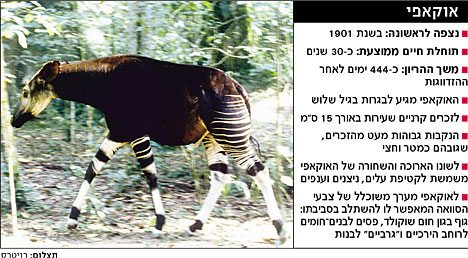Who knows why and why the zebra looks like a giraffe?
Delighted conservationists announced on Friday that they had found the winning proof of the existence of the okapi, a giraffe-like creature that managed to survive in Congo's war-torn Virunga National Park. The okapi was first observed in 1901 in the area that is now in the eastern Democratic Republic of the Congo, but since 1959 it has not been seen in the park, and although it was reported that it lived in other places in the Congo, there was concern that it was an animal that was extinct - at least in the habitat where it was first discovered - due to violations of the law and violence .
However, during field monitoring carried out by a conservation group on behalf of the organization for the protection of wild life (WWF) and the Congolese Institute for Nature Conservation, the traces of 17 okaps were discovered as well as other evidence of their presence in the area. The animal itself, which appears to be a cross between a giraffe and a zebra (long neck and striped hind legs), was not observed, but the tracks were accepted as unequivocal proof of the presence of the individuals in the park. Until now, the okapi, considered the only relatives of the giraffe, lived in the remote forests of eastern Congo.
"The presence of okapi in Virunga Park is a positive sign," said Mark Lange of WWF's East Africa Conservation Program. "Now, after establishing peace in the country, this is proof that the protected areas in this war-torn region have once again become the land of refuge for rare animals," said Langi. The okapi's habitat in eastern Congo has been a scene of war for years, as well as the center of the civil war that broke out in 1998 that killed millions. In this war, other African countries also took part.
Congo hopes to put bloodshed and anarchy behind it, ahead of the first democratic elections to be held next month, after more than 40 years. However, wandering rebels and members of various militias continue to fight in the east of the country. "Apart from the mountain gorillas whose numbers have increased as a result of an extensive conservation project, most of the wild animals in Virunga Park have suffered severely from the phenomenon of illegal hunting. The hippo population, for example, has shrunk from 29 individuals in the mid-seventies, to less than a thousand today," said the WWF statement.
The okapi was first discovered in 1901. Its long, black tongue is used to pick leaves, buds and branches from trees and shrubs for food. Males have 15 cm long horns. The fur of the females is sometimes reddish, and they are slightly taller than the males (who are about a meter and a half tall). The okapi has developed a set of camouflage colors that allows it to blend in with its surroundings. Its colors vary between a brown body, white-brown stripes across the thighs and white "socks". Deforestation and illegal hunting threatened the survival of the okapi, which was defined as an endangered species, but not really endangered.

https://www.hayadan.org.il/BuildaGate4/general2/data_card.php?Cat=~~~504606440~~~32&SiteName=hayadan
